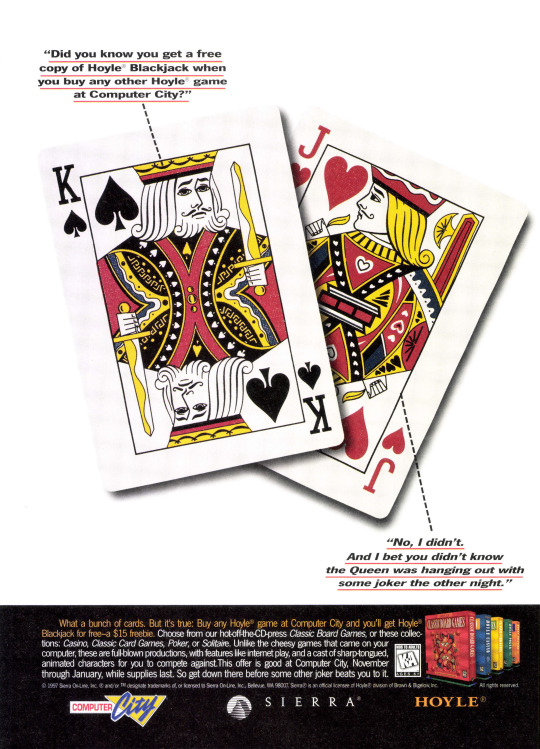#ibm cards
Explore tagged Tumblr posts
Text

An absolute tell for a Boomer: familiarity with the phrase “Do not fold, spindle or mutilate.”
10 notes
·
View notes
Text







🇺🇲 113 years ago, on June 16, 1911, the Computing-Tabulating-Recording Company (CTR) was formed by merging three smaller companies. Specializing in office products like punch card tabulators, CTR would later become known aslegendary International Business Machines (IBM) in 1924.
👉 This marked the beginning of a journey that would see IBM revolutionize the tech industry and become a global leader in computing.
#techtime chronicles#old technology#old tech#tech#technology#companies#electronics#information technology#technews#corporations#ibm corporation#ibm#ibm pc#ibm legacy#ctr#computing-tabulating-recording company#computing#computers#computer#company#digital#software#software development#hardware#thinkpad#os2#card tabuletors#tech industry#tech innovation#made in america
40 notes
·
View notes
Text
Oh hey, look at that! Nokia still sells phones (including modern versions of the early flagship phones I love so much)! They've also expanded to smartphones and tablets over the years, and all the prices I'm seeing are insanely affordable compared to most other mobile tech brands.
So it turns out that when my current phone finally beeps it's last text tone, I really *can* just replace it with a basic old Nokia phone and a tidy lil tablet, and all for fractions of what I paid for the current one!
Now all I need to do is find the desktop computer version of Nokia as a company so I can finally replace my desktop for work.
#does anyone know what desktop computer company sells that could handle both fff14 and 6hrs daily of video conferencing?#i don't need it to have a high storage capacity#i plan to get an external harddrive for all my work files to better secure them#but i DO want to be able to play an mmorpg with the kind of graphics card demand that would have made early ibm engineers cry
28 notes
·
View notes
Text

IBM 80 column punch card - circa 1966.
#ibm#ibm punch cards#ibm computers#computers#computing#vintage computers#vintage computing#international business machines#punch cards#computer punch cards#vintage tech#vintage technology#electronics#vintage electronics#calculators#technology#engineering#computer systems
7 notes
·
View notes
Text

USA 1997
#USA1997#NEWCOM#HARDWARE#MULTIMEDIA#IBM#NEWCOM HIGH FIDELITY SOUND CARD#NEWCOM AUDIOPHILE MULTIMEDIA KIT
12 notes
·
View notes
Text
Personal magic cards and dungeons and castles

Pixel art for today based on videogame Arcana for game console Super Nintendo. It is role playing game about dungeons. Maybe it is like dungeons and dragons. But with some style of Japanese drawing. And of course - fantasy. Game is something mystical plane, I think, according to title Arcana. And it is something like tarot cards it has. Maybe it is a very interesting adventure.
And this is my drawing about same theme. Owners of magic cards are often to go into the dungeons. Very depth dungeons and they are very far. They can stay there about several months. In a search of new magic cards and rare items. But danger is hidden in monsters which are crawling from darkness. Magic cards you find in dungeons gives you a right to be a magician. And you are set them on yourself. And nobody can take them from you. Problems is that to find them – it is not so easy.
And, also, there is a king’s game. IT is about killing rare and dangerous monsters. For some of them there are even maps. What dungeons they are located, and what certain area of the dungeon. As a rule it is a rare monsters and big one. Octopus with lots of eyes. And he has a legs and arms. And he striking with poison. And fire everything with his eyes. For example.
And start your search for magic cards you can from walking into little dungeons and destroying lots of rats. Labyrinths can be different – small and big. And rats are appearing again and again. To destroy them all - it is absolutely impossible.
Owners of magic cards can exchange them for gold or receive some bonuses in cities. This magic has a personal character and cards are set up to their owners. But you can exchange them or set to someone else.
Sum of your personal magic cards gives you - your magic level. And one day you can become even an owner of your own castle. When you will receive level 100. Behind a defense magic barrier and in a wild dangerous lands. But anyway -it is your own castle. But at this point your adventures do not to stop at all – and only begins. Around your territory it will be lots of dungeons with monsters.
And also, you will be waiting for a king`s game second level. If you will be possible to complete a ten valuable tasks and destroy a phoenix dragon then you will receive a reward as a access to magic library of the kingdom. It fly in the air. Just to think, a flying castle in the air.
So, this or that, lots of those who wants to become and owner of a personal magic cards. And you are one of them. Today it is excellent day to try yourself in magic!

Dima Link is making retro videogames, apps, a little of music, write stories, and some retro more.
WEBSITE: http://www.dimalink.tv-games.ru/home_eng.html ITCHIO: https://dimalink.itch.io/ GAMEJOLT: https://gamejolt.com/@DimaLink/games
BLOGGER: https://dimalinkeng.blogspot.com/
#8 bit#16 bit#super nintendo#megadrive#nes#ms dos#ibm pc#pixel art#drawing#2d art#game art#dungeons and dragons#fantasy#dungeons#maze#castle#magic#personal magic cards#monsters#dungeon crawler#labyrinth#retro game#retro aesthetic#pixel aesthetic
7 notes
·
View notes
Text
Got this book in a used bookstore and the bookmark is a IBM5081 punch card

60 notes
·
View notes
Text
6 notes
·
View notes
Text
Un día como hoy (14 de noviembre) en la computación

El 14 de noviembre de 1964, IBM introduce al mercado la nueva perforadora de tarjetas de 80 columnas, la IBM 29 #retrocomputingmx #ibm29
0 notes
Text
Just found out that my library app shows the date your account was registered. Now, I have lived in the same county my whole life, and I know I have been going to these libraries since I was a small child.
But even I didn't expect to find out that I have officially had a library card since I was THREE.
#I couldn't even read yet!!#A+ parenting (serious)#and yes I did immediately text my parents to congratulate them on this fact#frankly kind of stunned that information has made it through so many database changes#the library computers were green text IBM when I was registered#(I have of course had like 15 different physical cards because I lost them so often)
1 note
·
View note
Text
Post #172: The World Of IBM workplaces during the 1960s.

Women digitize the world via IBM punch card in 1965.
1K notes
·
View notes
Text

The first simulated image of a black hole, calculated with an IBM 7040 computer using 1960 punch cards and hand-plotted by French astrophysicist Jean-Pierre Luminet in 1978
2K notes
·
View notes
Text

lmao what
Tired of users loading malware into your mainframes? Got tricked into making the mainframe into a blockchain miner? Solve all your problems from bad data with this unique Antivirus Punch Card. Simply run this card through the punch card reader until it is fully integrated into your system. Then your system will reject any bad punch cards from being loaded. Lovingly crafted on a manual keypunch with New Old Stock punch cards. Options: White - Generic 5081 punch card Red - Globe No. 1 5081 punch card Green - IBM United Kingdom 5081 punch card Set of Three - One of each white, red, and green punch cards Note: This is a novelty product. Use in actual card readers at your own risk. This is a lace card, a punch card with every spot punched out, that rejects bad data by breaking apart and jamming the card reader, preventing all data.
this ko-fi store rules
1K notes
·
View notes
Text

The first simulated image of a black hole, calculated with an IBM 7040 computer using 1960 punch cards and hand-plotted by French astrophysicist Jean-Pierre Luminet in 1978
#black hole#art#space#computer#digital#digital art#deep space#dark#dark aesthetic#aesthetic#drawing#hand drawn#machinery#jpeg#information#astro#astrophotography#astronomy#x
336 notes
·
View notes
Text

USA 1997
#USA1997#SIERRA#GAMBLING#STRATEGY#IBM#MACINTOSH#HOYLE CASINO#HOYLE CLASSIC BOARD GAMES#HOYLE BLACKJACK#HOYLE CLASSIC CARD GAMES#HOYLE POKER#HOYLE SOLITAIRE
16 notes
·
View notes
Note
Why do 3.5 inch floppy disks seem so much more pleasant and edible than the 5.25 inch ones?
cause they are.
5.25″ and 8″ disks were designed by IBM engineers who wouldn’t know good consumer good design if it bit them on the cock. They designed shit for Men With Short Hair And Pocket Protectors who did Important Work at like Raytheon or something.
The 3.5″ was designed by Sony, who had been building appliances for the home since the 40s. They designed TVs and radios and the Walkman: They knew how to design a pleasant object to use in the home, and they understood all the sort of design choices that entails!
It needs to be pleasant to look at, it needs to be sturdy so it can handle being dropped and stuffed into bags, and it needs to not look too “computery” to scare off the non-technical users. The 3.5″ floppy disk is an example of all those design goals applied to the overly-computery floppy disk, and they knocked it out of the park. The 3.5″ disk is very touchable, because it was designed to be from the beginning. They expected people to handle them, because that’s what stuff for the home is supposed to be. It’s a thing like a credit card, you can pick it up and play with it or stick it in your pocket or purse and it can just deal with that, because it is designed to be used by humans, as part of their everyday life. The older floppies are just some computer stuff designed to be used by trained technicians who knew how to handle it delicately and not damage it.
389 notes
·
View notes